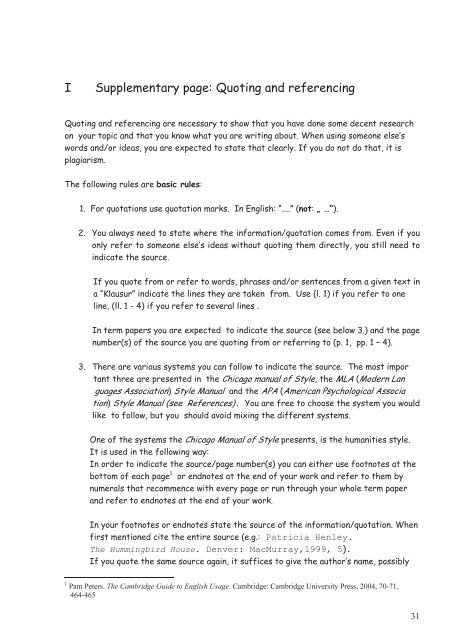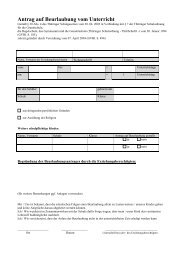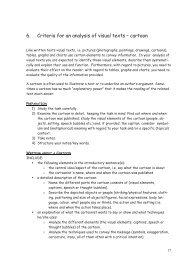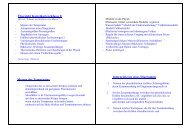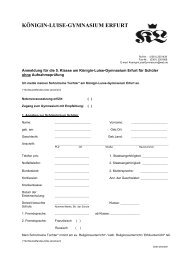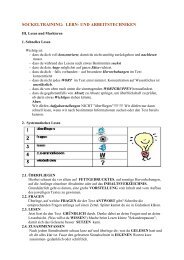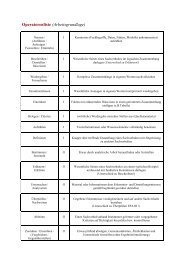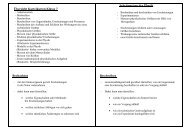I Supplementary page: Quoting and referencing
I Supplementary page: Quoting and referencing
I Supplementary page: Quoting and referencing
Create successful ePaper yourself
Turn your PDF publications into a flip-book with our unique Google optimized e-Paper software.
II<strong>Supplementary</strong> <strong>page</strong>: Linking wordsLinking words <strong>and</strong> phrases join clauses, sentences <strong>and</strong> paragraphs. They will help you linkyour ideas, point out similarities, highlight differences, justify statements or provide examples<strong>and</strong> conclusions.Frequently used linking words are: for example, <strong>and</strong>, because, moreover, as a result, however.Note that they are used in very different contexts.Most linking words can either connect clauses or start a sentence to form a link betweensentences. Generally you should avoid starting a sentence with or, <strong>and</strong> or but. If linkingwords start a sentence, they are followed by a comma.nevertheless, … … <strong>and</strong> the hotels had very high st<strong>and</strong>ards. Nevertheless, some touristscomplained about …in conclusion, … … In conclusion, if there is a moral obligation to protect life, gene technologyshould be a questionable choice for scientific researchers.If you are not sure about the usage, consult a good monolingual learner’s dictionary.NOTE: This is not a comprehensive list. You might want to add your own linking words <strong>and</strong>phrases.If you want to add to your argument:additionally, … zusätzlich … …, too. auchin addition, … noch dazu, außerdem moreover, … außerdem, weiterapart from … abgesehen davon ... <strong>and</strong> ... undbesides … ferner, überdies also, ... außerdemfurthermore, … außerdem, ferner ... as well as … so wie auchIf you want to emphasise a statement:apparently offenbar, scheinbar evidently offensichtlich, zweifellosnaturallynatürlich, selbstverständlichobviouslyoffensichtlich, klarhardly likely kaum wahrscheinlich undoubtedly, … zweifellosactually tatsächlich in fact genaugenommenIf you want to make comparisons:similarly, … ähnlichin the same way … ähnlichsimilarly annoying ebenso ärgerlich... likewise … ebenso, gleichfalls equally, … gleichermaßencompared to/with Im Vergleich zu equally slow(ly) gleich langsam…not only … but also…nicht nur, sondernauch …… just like … wie auch34
If you want to highlight contrast/show differences:although … obwohl in contrast (to) … im Gegensatz zuyet, … aber dennoch, doch neither … nor … weder … nochdespite … ungeachtet dessen nevertheless, … nichtsdestotrotzin spite of trotz whereas, … während, wohingegenhowever, … jedoch, dennoch on the one h<strong>and</strong> …on the other (h<strong>and</strong>)einerseits … <strong>and</strong>ererseitsWhen providing reasons:because (of) … infolge dessen /vondue towegenin this way … auf diese Art undfor this purpose … Weise, deswegenfor this reasonon the basis ofso thatsoaus diesem Grundauf Grund vonsodassdeshalb, daherWhen explaining results:accordingly, … demgemäß, entsprechendas a consequencefolglichas a result, ... folglichconsequently folglichin consequenceowing to this, ...therefore, ...folglichinfolge, wegendeshalbhence, ... folglich, daher thus, … somit, folglichWhen providing examples:…, for example … zum Beispiel … …, such as … wie (z.B.) ……, for instance … z.B. ... …, including … einschließlich…, e.g. … z.B. ... ..., namely … nämlich …..., i.e. ... d.h. …When showing a sequence (of events):first .../firstly ... erstens another (point) ein weiterer (Punkt)last but not least, … nicht zuletztsecond …/secondly zweitens finally /last… schließlich, zuletztnext …als nächstesWhen drawing conclusions <strong>and</strong> summing up:all in all, ... alles in allem in brief, … kurz gesagtas a result, … Als Ergebnis in conclusion, … abschließendon balance, …finally, …in other words, …alles in allemabschließendmit <strong>and</strong>eren Wortentherefore, …to conclude, …to sum up, …daherabschließendzusammenfassend35
III <strong>Supplementary</strong> <strong>page</strong>: Analysis of written textsRemember, your main goal is to explain how <strong>and</strong> why the author uses all kinds ofmeans to make his/her point <strong>and</strong> the effect this has on the reader.The following lists are meant to give you some survey <strong>and</strong> help. So do not just enumeratedevices or list which are missing without drawing any conclusions.When analysing literary (fictional) texts, you can check the following aspects: text type (sonnet, one-act play, short story) theme(s) (love, loneliness, conflict between partners/different groups) characterisation (direct, indirect/ex-, implicit; flat, round; (telling) names, appearance,way of thinking <strong>and</strong> speaking) setting (time, place, atmosphere, social background – in a drama that is often givenin the stage directions) action/plot (internal, external action; exposition, rising/falling action, climax, turningpoint; surprise/open ending; suspense; flashback, foreshadowing/ anticipation) point of view (first-/third-person, omniscient, limited, selective omniscient, observernarrator) mode of presentation (telling, showing; panoramic, scenic; interior monologue,stream of consciousness, reported thought) rhetorical/stylistic devices (metaphor, symbol, alliteration, contrast, enumeration,personification, repetition, rhetorical question, wordplay) formal aspects (stanza, refrain, rhyme (scheme), metre/rhythm; act, scene;chapter, part)With regard to non-literary (non-fictional) texts you can check the text type (newspaper article, editorial, letter to the editor, advertisement, (political)speech) purpose/intention (information, argumentation, persuasion, exaggeration, praise,criticism, entertainment) structure/layout (headline, subheading, topic sentences; introduction, main part,conclusion; sequence of facts, paragraphs, columns; print, visual additions)In most texts it is also useful to have a look at the use of language.You can take into consideration: register (neutral, formal, informal, colloquial language, slang, taboo words) wording (choice of words, connotations, ambiguity, wordplay) syntax (simple, complex, incomplete sentences; active, passive constructions) tone (serious, objective, ironic, humorous, witty, emotional, sentimental) rhetorical devices (direct address of the reader, rhetorical questions, repetition,emphasis, enumeration, examples, quotations)36
IV <strong>Supplementary</strong> <strong>page</strong>: Writing about a cartoonHere are some useful expressions that will help you write about a cartoon.What kind of picture is it ? Where is it from? What is it about?The cartoon by...publishedin...In his/her cartoon, publishedin..., X/YThe scene depicted in thecartoon by ... published in...is aboutshows/presentsdepictsdeals withaddressesalludes torefers tocriticisesis directed at/targetscomments onexposes the fact thatthe attitude towardsthe problem ofthe current discussion onthe policythe trendthe use ofpeople whoWhat is depicted?The cartoonIn the foreground/backgroundIn the middle/centreAt the top/bottomOn the left/rightIn the top right-h<strong>and</strong> cornerIn the bottom left-h<strong>and</strong> cornerconsists ofis made up ofhasis divided intothere is/you can see ...(a ... /several .. )(a/a number of)... can be seena ... is shown/depictedseveral ... are depictedseveral visual elementsspeech or thought bubblesdifferent framesa captionx parts The man/woman is characterised/depicted as someone who ... She/he looks as if ... She/he appears to be/doing... It seems as if ... She/he seems to be/be doing … Mr Y looks bigger than... as he is positioned in the foreground.The captionstates that...explains …is a comment/statement by ...37
plainly shows that ...reinforces the impression ...forms a contrast to the pictureis unexpected/short/ very funnyWhat is the message <strong>and</strong> which techniques are used to convey it? The cartoon expresses/points out/aims to show ... The cartoon conveys the message that ... The key point the cartoon is trying to make is to expose the fact that... The message of the cartoon is obvious/plain The scene epitomises ... (= verkörpert/ist der Inbegriff von ...) The cartoonist’s message is clear/unclear The cartoonist emphasises/criticises/wants to express the idea that… The cartoonist seems to criticise/ridicule/call into question ... It is obvious/plain to see that ... What we learn from the cartoon is ... X (an element in the drawing/he/she/it) st<strong>and</strong>s for/represents/symbolises/shows … X is exaggerated/stressed … X is a caricature of .../X is the stereotypical ... X is caricatured/ridiculed as ... This indicates that ... It is obvious from the way X is depicted that ... This assumption is supported by the fact that ... The humour lies in the difference/misunderst<strong>and</strong>ing/discrepancy/contrast/parallelsbetween ... <strong>and</strong> ...What is your personal opinion? The cartoon appeals/does not appeal to me. In my opinion ... The cartoon is complex/well done/very clever/effective/of high quality/convincing/entertaining. The cartoon is simplistic/confusing/unfair/hurtful to/exaggerated. The cartoon achieves its aim of ...-ing. It skilfully/effectively ... The point the cartoon is trying to make appeals to me/does not appeal to me because... The message of the cartoon is lost on me/fails to work for me because ... I entirely/partly agree with ... I have my doubts as to ... The message needs further explanation.How do caption/text <strong>and</strong> cartoon fit together? The text supports the message of the cartoon because … Nevertheless, some detail provided in … does not appear in … Whereas the text says … the cartoon seems to imply … In contrast to the cartoon, the text …38
V <strong>Supplementary</strong> <strong>page</strong>: Collecting information from charts<strong>and</strong> tablesLanguage note:TensesUse past tense when focusing on one point in time in the past.Use present perfect tense when referring to a period from the past to now.Use simple present tense for accepted facts. You may also use it when discussing yourresults <strong>and</strong> conclusions.PluralThe statistics show ... (usually used in the plural).The media have to be considered …. (plural word).Only a small percentage of people are ... (use plural verb if the noun that follows a percentageof is plural).In British English in particular many collective nouns such as “majority”, “minority”, “rest”are used preferably with plural verbs (”the majority are....”). Also note: The number ofinhabitants has decreased since 1999. A number of inhabitants have left the city.The form “data” can be used with a singular or plural verb (The data is ... /are ...).“Police” is always used in the plural: The police have been looking for likely suspects.Amount <strong>and</strong> numberUse “amount” with uncountable nouns <strong>and</strong> “number” with countable nouns.A massive amount of paper, a large amount of money ..., but: the number of children /ofmiles...39
IntroductionWhat is the graph/chart about?What is the source of the material?What does thegraph/chart/table refer to?What is the content? ( weights,measures, currency...)What is the time span covered?In what way is the informationpresented?Description (Describe Figure 1 /Table 2 /Document 3)The graph/chart is about … /deals with …It is taken from ...The graph/chart/table shows the relationship between …<strong>and</strong> …The table compares the population in terms of/with respectto/with regard to marital status <strong>and</strong> annual income(in dollars).It covers a period of ... .months/years ...It depicts a development of three months/years from2002 to 2005.This is a bar chart/pie chart/line graph/table.The vertical/horizontal line shows/represents ...The figures are expressed as a percentage of the totalpopulation/total number of ...The data are presented in absolute numbers.Is there a general development?What is the highest/lowestpoint?Is there anything striking? Arethere any irregularities?The line/size/weight … rises/increases/decreases …slowly/gradually /more steeply/almost vertically/there isno change...There has been a noticeable/distinct increase in thenumber of/drastic reduction in volume/dramatic fall inthe proportion of...The upward development/downward trend continues.The number/proportion/frequency/amount of ... haschanged slightly/steadily/sharply/markedly/dramatically/significantly.The unemployment figures stagnate/remain stable.The rates fluctuate widely/considerably/from year toyear.From 1985 to 1990 the population declined from 40,000to 30,000 inhabitants.The average of … is …African-Americans account for 12% of the US population.This amounts to a total of ...... production reached a low/peak/peaked in 2005The minimum/maximum weight/size/depth is …Only a small percentage of people are ...This amounts to a total of ...40
Comparison (Compare the developments depicted in Figure 1 with each other. Do the data presented inthe table back up the information provided in the text? Say why/why not.)Are there any similarities<strong>and</strong>/or differences with respectto the different data/pieces ofinformation/developments …given?Comparing the different data with each other we cansay that …The country with the highest/lowest population density/biggest/smallestarea is …The amount in … is higher/lower in … than …The number is about three times higher than ...They employ twice as many as ... It is twice the size of ...While figure 1 reflects … figure 2 shows …Generalisation (Sum up the main information supplied in Document 1.)What are the most importantdata/observations/developments?Generally speaking, /By <strong>and</strong> large, /All in all, /Summingup, …Explanation/interpretation/prediction/evaluation (Explain/assess the development depictedin …. Analyse the data presented in …. Comment on the development shown in ….What are the reasons for thedevelopments shown?Can the different data/variousdevelopments be related to eachother?What predictions can be made?We can account for this development by looking at...The statistics for London/for 2005 ... show/reveal that...Due to/... because of …The number/rate of ... is expected/predicted/likely todrop/fall after 2010.In my opinion this trend will continue.Judging by/from ...Do the data <strong>and</strong>/or developmentsdepicted in the chart,graphs <strong>and</strong>/or table confirmwhat you know about the topic?The data confirm/support the thesis/information ...The data are not consistent with other figures.The information does not seem to be trustworthy.The chart conveys a false impression.41
VI <strong>Supplementary</strong> <strong>page</strong>: Sample formal letteryour address in the top right-h<strong>and</strong> cornerdate under youraddress on the right(in American English: May 4, 2008)addressee on the left1, Craigshiel PlaceAyr KA7 4BZScotl<strong>and</strong>In a business letter, you canstate the subject of yourletter in an extra line.Maryport AquariaSouth QuayBrighton BN2 9SPEngl<strong>and</strong>4 May 2008Application for a work placementsalutationCapitalise thefirst letter afterthe salutation.All paragraphsbegin at leftmargin.Dear Sir or Madam,I am a student from Brighton’s twin town, Passau, inGermany. Next year, from 14 – 25 January, a group ofour students are planning to come to Engl<strong>and</strong> to gainwork experience.Whereas most are taking work placements arranged byour partner school, I am writing to ask you for the opportunityto come to the Aquaria on work experience,as I am very interested in marine biology. I am preparedto work <strong>and</strong> study hard if given the chance.I enclose my CV <strong>and</strong> look forward to hearing from yousoon.Yours faithfullyclosing formula(in American English:Sincerely),h<strong>and</strong>written signaturetypewritten nameAngela BurnsAngela Burns42
VII <strong>Supplementary</strong> <strong>page</strong>: Sample letter to the editorA letter to the editor follows most of the conventions of a formal letter (see p. 38). Note,however, that nowadays letters to editors are often sent via email. Most newspapers <strong>and</strong>magazines offer contact information on their internet sites.your address in the top right-h<strong>and</strong> corneraddressee on the leftdate under youraddress on the rightIn a letter to the editor,omit "Dear".LettersThe Guardian25 St James's StreetLondon SW1A 1HGUnited KingdomSir / Madam1, Craigshiel PlaceAyr KA7 4BZScotl<strong>and</strong>4 May 2008In the first sentence saywhy you write/whichletter/article you referto.In a letter to the editor, omitthe closing remarks <strong>and</strong> simplysign your name <strong>and</strong> stateyour place of residence.I am writing in response to the article "The need to belong– but with a strong faith" in the issue of 17 June,2002.I would like to congratulate you on the impartial viewsexpressed there…..Julie Winstontown, countryAs to the content of your letter: clearly state your purpose: Makeclear right away if you want to criticise, support or add information.Confine yourself to the most important argument. You mighthave to repeat a certain argument presented in the newspaperarticle in question to show what you are referring to, but do nottell the journalists what they have written themselves.43
VIII<strong>Supplementary</strong> <strong>page</strong>: How to improve my writingRecognizing your strengths <strong>and</strong> weaknesses helps you to overcome your problems <strong>and</strong> guaranteesa lasting improvement on your work. Here are some suggestions:Do not forget: Making mistakes is part of learning. You should not try to write withoutmaking any mistakes. Instead, try to find out what you -personally- must focus on to improveyour writing. By finding your personal focus points you will realize what to work on.To find your focus points you could find out which of your wordings make it difficult to underst<strong>and</strong> you ask fellow students if they can underst<strong>and</strong> what you want to say compare the results of your self-assessment grids <strong>and</strong> determine points you shouldfocus on modify the provided self-assessment grids according to your needs devise your own self-assessment gridsTo work on your focus points you could look at texts you have written <strong>and</strong> find out which of your wordings are really suitableto express your thoughts – maybe you should use them more often look at your fellow students’ work <strong>and</strong> copy good ideas/wordings correct wordings that make it hard to underst<strong>and</strong> you with the help ofo a dictionaryo a grammar booko the interneto class mateso the teacher maintain a card index of your corrections devise a poster with useful phrases/corrections <strong>and</strong> put it up at home/in class devise a self-assessment grid to check grammar/sentence structure/style thatmeets your needs for particular focus pointso rewrite/correct all your wordings containing a particular focus pointo revise relevant chapters in a grammar booko modify completed exercises for your personal needso analyse completed exercises (Have they been useful to you? Why? Why not?)o do new exerciseso design new exercises (e.g. by modifying exercises you have already done)o revise vocabulary on certain subjects, e.g. using lists or mind-mapso extend your vocabulary by e.g. finding synonyms <strong>and</strong> antonyms of words that caused difficulties looking up <strong>and</strong> learning expressions that contain the word that caused problems devise new vocabulary lists or mind-maps44
IX ReferencesAczel, Richard: How to Write an Essay. Stuttgart: Klett, 2003Bruck, P. et al. (Hrsg.): Skyline. Advanced Level. Ausgabe C. Stuttgart: Klett, 2003Bülow, F.M. et al. (Hrsg.). Learning English - Top Line. Lese- und Arbeitsbuch für die 12. und 13. Klasse.Stuttgart: Klett, 1992CPA (Hrsg.): How to write a letter to the editor. http://www.acp-cpa.ca/lettertoeditortips.htm[07.11.06]FAIR (Hrsg.): How to communicate with journalists.http://www.fair.org/ [06.11.06]Firnkes, F.; Kammerer, H.: Üben fürs Abi – Textproduktion Englisch. Stuttgart: Klett, 2001Freese, P. (Hrsg.): Viewfinder Special. Lese- und Arbeitsbuch für die gymnasiale Oberstufe. 2. Aufl.München: Langenscheidt-Longman, 1999GMU Writing center (Hrsg): Sample Business Letter.http://www.gmu.edu/departments/writingcenter/letter.html [06.11.06]Hamburger Bildungsserver (Hrsg.): Intensivkurs im Fach Englisch. Texte und Aufgaben für die Vorstufeder gymnasialen Oberstufe. http://hamburgerbildungsserver.de/oberstufe/intensivkurs_englisch.pdf[04.10.06]Jewell, Richard: Writing an Analysis. CollegeWriting.Info.http://www.tc.umn.edu/~jewel001/CollegeWriting/WRITEREAD/Analysis/default.htm [03.11.07]Kemnitz, R. et al.: How to deal with texts. A systematic approach to the analysis of texts. Frankfurta.M.: Diesterweg, 1994Kirschning, K.: Business letters for beginners. Darmstadt: Winklers Verlag, 2000L<strong>and</strong>esbildungsserver Baden-Württemberg (Hrsg.): Cartoon Analysis Guide. http://www.schulebw.de/unterricht/faecher/englisch/eunterricht4/wortschatz/cartoon2[04.01.07]LISUM (Hrsg.): Fachbrief Nr. 6 Englisch.http://www.lisum.de/Inhalte/Data/unterrichtsentwicklung/sprachen/englisch/sek2/fachbriefe/[19.01.07]McClintock, J. et al. (Hrsg.): Step Up. Texts, Topics <strong>and</strong> Language Activities for Advanced Learners.Frankfurt a.M.: Diesterweg, 1991Peters, Pam: The Cambridge Guide to English Usage: Cambridge University Press, 2004, 70-71, 464-465Sächsisches Staatsministerium für Kultus. Hinweise und Empfehlungen für die Gestaltung des Fremdsprachenunterrichtsin der beruflichen Bildung. Lampertswalde: Stoba-Druck, 2001Schwarz, H. (Hrsg.): New Context. Berlin: Cornelsen, 2003SenBJS et al. (Hrsg.): Rahmenlehrplan für die gymnasiale Oberstufe. Englisch. Gültig ab Schuljahr2006/07. http://www.berlin.de/imperia/md/content/senbildung/schulorganisation/lehrplaene/sek2_englisch.pdf[18.10.2006]Sicher ins Zentralabitur. Berlin, Br<strong>and</strong>enburg, Mecklenburg-Vorpommern. Arbeitsheft mitCD-ROM. 1. Aufl., Stuttgart: Klett 2006Steinbrecher, Armin; Vater, Dieter; Weiß, Gerhard: Eleven Plus. Topics for text skills. Berlin: Cornelsen,1986/1997Student Learning Center (Hrsg.): Linking words <strong>and</strong> phrases.http://www.flinders.edu.au/SLC/Linking_words.pdf [19.01.07]Swales, J. M.;Feat, C. B.: Academic Writing for Graduate Students. Essential tasks <strong>and</strong> Skills. AnnArbour: U Michigan P, 1994. S. 105-130Swan, Michael: Practical English Usage. Stuttgart: Klett, 1995Tepe, T.: Twenty-One New Short Shorts. Creative Exercises. Stuttgart: Klett, 1995The Chicago Manual of Style Online (15th edition). “Chicago-Style Citation Quick Guide”. University ofChicago Press. http://www.chicagomanualofstyle.org/tools_citationguide.html. [28.07.08]The Writing Lab <strong>and</strong> OWL at Purdue <strong>and</strong> Purdue University (Hrsg.): APA <strong>and</strong> MLA Formatting <strong>and</strong> StyleGuide. http://owl.english.purdue.edu/owl/resource/557/01/ [11.11.06]45
RecommendationsBoone, C.: Abi-Countdown. English Texts. Faktenwissen. 2. Aufl., Stuttgart: Manz, 2004.Bendl, H.: Abi-Countdown. Englisch Leistungskurs. Prüfungsaufgaben. 2. Aufl. Stuttgart: Manz, 2000.Firnkes, F.; Kammerer, H.: Üben fürs Abi – Textproduktion Englisch. 2. Aufl. Stuttgart: Manz, 2003Clarke, D.: Besser in Englisch. Abiturtrainer: Textarbeit. Oberstufe. Frankfurt a.M.: Cornelsen Scriptor,1995Clarke, D.: Besser in Englisch. Einführung in die Textarbeit. Oberstufe. Berlin: Cornelsen Scriptor,1989.Sicher ins Zentralabitur. Berlin, Br<strong>and</strong>enburg, Mecklenburg-Vorpommern. Arbeitsheft mitCD-ROM. 1. Aufl., Stuttgart: Klett 200646
XDocumentation sectionProject / Text type / Title Date PageWriting a summarySample summary 1: …Sample summary 2: …Self-assessment grid: Writing a summaryWriting a commentSample comment 1: …Sample comment 2: …Self-assessment grid : Writing a comment…<strong>Supplementary</strong> <strong>page</strong>: General advice on writing<strong>Supplementary</strong> <strong>page</strong>: Linking words47


